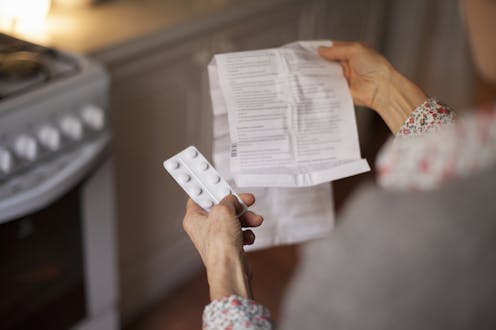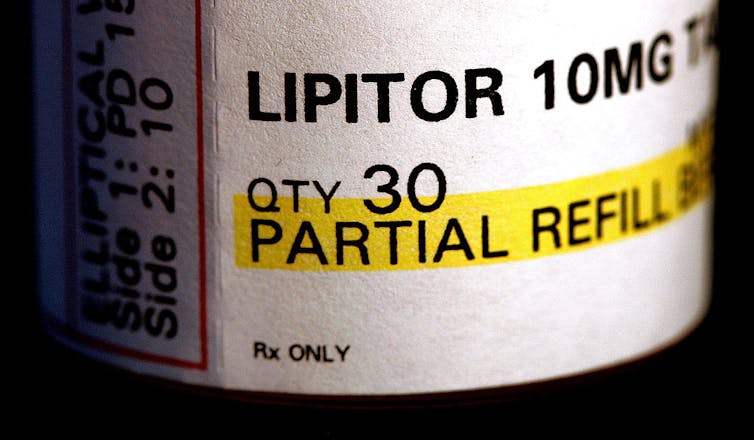Prescription drugs' fine print is important – a toxicologist explains how to decode package inserts
Don’t be intimidated by the package insert that comes with your medication. Learning how to read it can help you better understand how drugs work.

Many adults take prescription drugs, and usage rates are continually increasing. With approximately 1.3 million emergency department visits in the U.S. caused by adverse drug events each year, patient education is becoming increasingly important.
All prescription drugs come with instructions on how to safely and effectively use them. Depending on the medication, there may be several types of information included: the patient package insert, medication guide and instructions for use. One or more of these documents could be folded up in the box or attached as a printed page provided by your pharmacist.
I am a scientist who studies how drugs and other chemicals affect human health. While they may look intimidating, package inserts – and particularly the prescribing information – can help patients better understand the science inside the pill bottle and blister pack, among others.
What can I learn from package inserts?
An often overlooked part of the package insert is the prescribing information. Though written primarily for health care professionals, it contains a wealth of information regarding the ways in which the medication interacts with the body.
If the prescribing information was not included with your prescription, you can often find a copy on the National Institutes of Health’s DailyMed website or other drug information websites.
As an example, let’s consider one of the most widely prescribed medications in the U.S., atorvastatin (Lipitor). Among other effects, it reduces elevated levels of cholesterol overall as well as levels of low-density lipoprotein cholesterol – LDL, or “bad” cholesterol.
Reading the insert can answer a few important questions about the drug. If you’d like to follow along, a copy of the prescription information for Lipitor can be found here.

How does the drug work?
To answer this question, you can refer to the “Mechanism of Action” and “Pharmacodynamics” subsections of the prescription insert.
The mechanism of action and pharmacodynamics are related concepts. The mechanism of action describes the chemical and molecular interactions that cause a drug’s therapeutic or toxic effects. Pharmacodynamics refers to “what the drug does to the body,” which includes the mechanism of action as well as how other factors like drug concentration influences its effects.
Often the mechanism of action of a drug is related to how it interacts with cell receptors and enzymes involved in mediating specific signals and biochemical reactions in the body.
In the case of Lipitor, the prescribing information tells us three important things about how the drug works. First, the liver is the primary site that produces cholesterol in the body and the area the drug is meant to target. Second, the drug works by inhibiting an enzyme involved in cholesterol production called HMG-CoA reductase. And third, the drug increases the number of LDL cholesterol receptors on cell surfaces, ultimately increasing the catabolism, or metabolic breakdown, of LDL cholesterol.
Where does the drug go in my body?
Before we answer this question, let’s start with some background information in the “Pharmacokinetics” subsection.
Pharmacokinetics can be thought of as “what the body does to the drug.” It focuses on four major processes the body undergoes in response to the chemical: absorption, or how the drug gets into the body; distribution, or how the drug is dispersed throughout the body; metabolism, or how the drug is converted into other chemical forms; and excretion, or how the drug is eliminated from the body.
The pharmacokinetics of a drug are determined by factors related to the chemical itself and the person taking the medication. For instance, disease state, age, sex and genetic makeup can all cause the same medication to work differently in different people.

Now, let’s look at the “Distribution” subsection.
For Lipitor, the prescription insert does not specifically say where the drug goes in the body, but it does note that the volume of distribution is 381 liters. The volume of distribution is the ratio of the amount of the drug in the body overall to its concentration in the blood. A value greater than about 30 liters suggests that the drug has entered body tissues and is not confined to the bloodstream. For reference, the drug warfarin, which prevents blood clots, is tightly bound to proteins in the blood and has a volume of distribution of only 8 liters. On the other hand, chloroquine, an antimalarial drug that enters body fat, has a value of 15,000 liters.
Does the drug cause the effects or its byproducts?
Though the therapeutic effects of most drugs come from the chemical compound it’s made of, many break down into active metabolites in the body that also have some relevant biological effects.
Some medications are administered in an inactive form called a prodrug that the body converts into metabolites with the desired therapeutic effects. Drugmakers generally use prodrugs because they have better pharmacokinetics – such as improved absorption and distribution in the body – than the active form of the drug.
In the case of Lipitor, the “Metabolism” subsection under “Pharmacokinetics” tells us that the drug is broken down into several products and that these metabolites contribute significantly to its therapeutic effect.
How long will the drug be in my system?
A key drug property to consider in this case is its half-life, which is the length of time required for the concentration of the drug to decrease to half of its initial amount in the body. Information about a drug’s half-life is found in the “Excretion” subsection under “Pharmacokinetics.”
The half-life for Lipitor is approximately 14 hours. If you were to stop taking the medication, 97% of the drug would be gone from your blood after about three days, or five half-lives.
The prescription insert provides another interesting piece of information: because Lipitor’s active metabolites have a longer half-life than the drug itself, the half-life for its cholesterol enzyme inhibiting effects is 20 to 30 hours. This means that the drug’s effects may last even after the drug itself is out of your system.
Why do I need to take medications with food or at certain times?
Eating food can change the amount and rate at which a drug is absorbed into the body in several ways, including changing the acidity of the digestive system, altering the release of bile and increasing blood flow to the gut.
For Lipitor specifically, the answer to this question can be found in the “Absorption” subsection under “Pharmacokinetics.” Food decreases the rate and extent of Lipitor’s absorption but doesn’t significantly affect LDL cholesterol reduction.
Interestingly, the insert also states that the blood concentration of the drug is significantly lower when taken in the evening than in the morning, but reduction in LDL cholesterol levels is the same regardless of when the drug is taken.
The upshot of all of this is written on the drug label on the outside of the package: Lipitor can be taken with or without food. Morning or evening is not specified, but the recommendation is to take it at the same time every day.
Why does my doctor ask about other drugs I’m taking?
Drugs can interact with one another in ways that affect their safety and efficacy. For instance, two drugs may rely on the same enzyme system in the body to break them down. Taking them at the same time can ultimately lead to higher-than-anticipated levels of either or both drugs in the body.
Information to answer this question can be found in the “Drug Interactions” section.
One of the drug categories of concern for Lipitor are “strong inhibitors of CYP 3A4,” an enzyme that plays a key role in metabolizing many drugs. Because Lipitor itself is broken down by this enzyme, taking it alongside drugs that inhibit CYP 3A4, such as the antibiotic clarithromycin or the fungal infection drug itraconazole, can lead to its increased concentration in the blood and potentially result in adverse effects.
Brad Reisfeld does not work for, consult, own shares in or receive funding from any company or organisation that would benefit from this article, and has disclosed no relevant affiliations beyond their academic appointment.
Read These Next
DOJ criminal probe highlights risk of Fed losing independence – a central bank scholar explains what
The investigation follows Fed Chair Jerome Powell’s refusal to toe the White House’s line over interest…
What is Christian Reconstructionism − and why it matters in US politics
Christian Reconstructionism, a little-known movement to rebuild society on biblical law, can often shape…
Financial case for college remains strong, but universities need to add creative thinking to their c
The cost of college is on the rise – but college grads still earn more than those without a degree.






